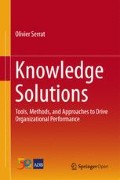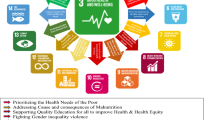Abstract
The sustainable livelihoods approach improves understanding of the livelihoods of the poor. It organizes the factors that constrain or enhance livelihood opportunities, and shows how they relate. It can help plan development activities and assess the contribution that existing activities have made to sustaining livelihoods.
You have full access to this open access chapter, Download chapter PDF
Similar content being viewed by others
Keywords
In a Word The sustainable livelihoods approach improves understanding of the livelihoods of the poor. It organizes the factors that constrain or enhance livelihood opportunities, and shows how they relate. It can help plan development activities and assess the contribution that existing activities have made to sustaining livelihoods.

Livelihoods
A livelihood comprises the capabilities, assets, and activities required for a means of living. It is deemed sustainable when it can cope with and recover from stresses and shocks and maintain or enhance its capabilities, assets, and activities both now and in the future, while not undermining the natural resource base.
The Sustainable Livelihoods Approach
The sustainable livelihoods approach is a way of thinking about the objectives, scope, and priorities for development activities. It is based on evolving thinking about the way the poor and vulnerable live their lives and the importance of policies and institutions. It helps formulate development activities that are.
-
People-centered
-
Responsive and participatory
-
Multilevel
-
Conducted in partnership with the public and private sectors
-
Dynamic
-
Sustainable

Source Author
Fig. The sustainable livelihoods framework.
The sustainable livelihoods approach facilitates the identification of practical priorities for actions that are based on the views and interests of those concerned but they are not a panacea. It does not replace other tools, such as participatory development, sector-wide approaches, or integrated rural development. However, it makes the connection between people and the overall enabling environment that influences the outcomes of livelihood strategies . It brings attention to bear on the inherent potential of people in terms of their skills, social networks, access to physical and financial resources, and ability to influence core institutions.
Appreciative inquiry—originally developed as a tool for industry to avoid negative approaches to problem solving—extends this constructive outlook. Appreciative inquiry is a highly inclusive process that maximizes the positive (as opposed to minimizing the negative) in which a community takes responsibility for generating and gathering information and then forms strategies based on the most positive experiences of the past.
Capital Assets
The sustainable livelihoods framework helps to organize the factors that constrain or enhance livelihood opportunities and shows how they relate to one another. A central notion is that different households have different access livelihood assets, which the sustainable livelihood approach aims to expand. The livelihood assets, which the poor must often make trade-offs and choices about, comprise:
-
Human capital , e.g., health, nutrition, education, knowledge and skills, capacity to work, capacity to adapt
-
Social capital, e.g., networks and connections (patronage, neighborhoods, kinship), relations of trust and mutual understanding and support, formal and informal groups, shared values and behaviors, common rules and sanctions, collective representation, mechanisms for participation in decision-making, leadership
-
Natural capital, e.g., land and produce, water and aquatic resources, trees and forest products, wildlife, wild foods and fibers, biodiversity, environmental services
-
Physical capital , e.g., infrastructure (transport, roads, vehicles, secure shelter and buildings, water supply and sanitation, energy, communications), tools and technology (tools and equipment for production, seed, fertilizer, pesticides, traditional technology)
-
Financial capital,Footnote 1 e.g., savings, credit and debt (formal, informal), remittances, pensions, wages
Vulnerability Context
Vulnerability is characterized as insecurity in the well-being of individuals, households, and communities in the face of changes in their external environment. People move in and out of poverty and the concept of vulnerability captures the processes of change better than poverty line measurements. Vulnerability has two facets: an external side of shocks, seasonalities, and critical trends ; and an internal side of defenselessness caused by lack of ability and means to cope with these. The vulnerability context includes
-
shocks, e.g., conflict, illnesses, floods, storms, droughts, pests, diseases
-
seasonalities, e.g., prices and employment opportunities
-
critical trends, e.g., demographic, environmental, economic, governance, and technological trends
Policies and Institutions
Livelihood strategies and outcomes are not just dependent on access to capital assets or constrained by the vulnerability context; they are also transformed by the environment of structures and processes. Structures are the public and private sector organizations that set and implement policy and legislation; deliver services; and purchase, trade, and perform all manner of other functions that affect livelihoods.
Processes embrace the laws, regulations, policies, operational arrangements, agreements, societal norms, and practices that, in turn, determine the way in which structures operate. Policy-determining structures cannot be effective in the absence of appropriate institutions and processes through which policies can be implemented. Processes are important to every aspect of livelihoods. They provide incentives that stimulate people to make better choices. They grant or deny access to assets. They enable people to transform one type of asset into another through markets. They have a strong influence on interpersonal relations. One of the main problems the poor and vulnerable face is that the processes which frame their livelihoods may systematically restrict them unless the government adopts pro-poor policies that, in turn, filter down to legislation and even less formal processes.
Livelihood Strategies and Outcomes
Livelihood strategies aim to achieve livelihood outcomes. Decisions on livelihood strategies may invoke natural-resource-based activities, nonnatural resource-based and off-farm activities, migration and remittances, pensions and grants, intensification versus diversification, and short-term versus long-term outcomes, some of which may compete. (One of the many problems of development is that projects and programs, while favoring some, can disadvantage others.Footnote 2) Potential livelihood outcomes can include more income, increased well-being, reduced vulnerability , improved food security, more sustainable use of the natural resource base, and recovered human dignity, between which there may again also be conflict.
Implications
The sustainable livelihoods approach encourages thinking out of the box. It frees development practitioners from conventional approaches that are often restricted to identifying problems and finding solutions. It invites them to look at contexts and relationships so that development activities can become more process-oriented. It compels them to look for multiple entry points and to move beyond a homogenous “community” view and a narrow sectoral perspective. It represents an important shift away from the focus on project inputs and outputs and the assumed mechanical links between them. In particular, the sustainable livelihoods approach stresses the importance of understanding institutions by mapping the institutional framework and linking the micro to the macro and the formal to the informal Therefore, it calls for a new style of policy appraisal that moves from universal prescriptions to context-specific approaches that allow alternative, local perspectives to reveal themselves in the policy framework.
Caveat
The sustainable livelihoods approach is only one way of organizing the complex issues that surround poverty. It must also be made appropriate to local circumstances and local priorities.
Box: The Sustainable Livelihoods Framework—Strengths and Weaknesses
Strength | Weakness |
|---|---|
Seeks to understand changing combinations of modes of livelihood in a dynamic and historical context | Underplays elements of the vulnerability context, such as macroeconomic trends and conflict |
Explicitly advocates a creative tension between different levels of analysis and emphasizes the importance of macro- and microlinkages | Assumes that capital assets can be expanded in generalized and incremental fashion |
Acknowledges the need to move beyond narrow sectoral perspectives and emphasizes seeing the linkages between sectors | Does not pay enough attention to inequalities of power |
Calls for investigation of the relationships between different activities that constitute livelihoods and draws attention to social relations | Underplays the fact that enhancing the livelihoods of one group can undermine those of another |
Notes
- 1.
Financial capital tends to be the least available livelihood asset of the poor. Indeed, it is because the poor lack it that the other types of capital are so important to them.
- 2.
There is no quick fix for this problem. Its existence underlines the need to give choice and opportunities to the poor and build their ability to take advantage of these, and extend safety nets for those who still cannot achieve their livelihood objectives in a competitive environment.
Further Reading
ADB (2004) Future solutions now—the tonle sap initiative. December
Author information
Authors and Affiliations
Corresponding author
Rights and permissions
The opinions expressed in this chapter are those of the author(s) and do not necessarily reflect the views of the Asian Development Bank, its Board of Directors, or the countries they represent.
Open Access This chapter is licensed under the terms of the Creative Commons Attribution-NonCommercial 3.0 IGO license (http://creativecommons.org/licenses/by-nc/3.0/igo/) which permits any noncommercial use, sharing, adaptation, distribution and reproduction in any medium or format, as long as you give appropriate credit to the Asian Development Bank, provide a link to the Creative Commons license and indicate if changes were made.
Any dispute related to the use of the works of the Asian Development Bank that cannot be settled amicably shall be submitted to arbitration pursuant to the UNCITRAL rules. The use of the Asian Development Bank’s name for any purpose other than for attribution, and the use of the Asian Development Bank’s logo, shall be subject to a separate written license agreement between the Asian Development Bank and the user and is not authorized as part of this CC-IGO license. Note that the link provided above includes additional terms and conditions of the license.
The images or other third party material in this chapter are included in the chapter’s Creative Commons license, unless indicated otherwise in a credit line to the material. If material is not included in the chapter’s Creative Commons license and your intended use is not permitted by statutory regulation or exceeds the permitted use, you will need to obtain permission directly from the copyright holder.
Copyright information
© 2017 Asian Development Bank
About this chapter
Cite this chapter
Serrat, O. (2017). The Sustainable Livelihoods Approach. In: Knowledge Solutions. Springer, Singapore. https://doi.org/10.1007/978-981-10-0983-9_5
Download citation
DOI: https://doi.org/10.1007/978-981-10-0983-9_5
Published:
Publisher Name: Springer, Singapore
Print ISBN: 978-981-10-0982-2
Online ISBN: 978-981-10-0983-9
eBook Packages: Business and ManagementBusiness and Management (R0)




